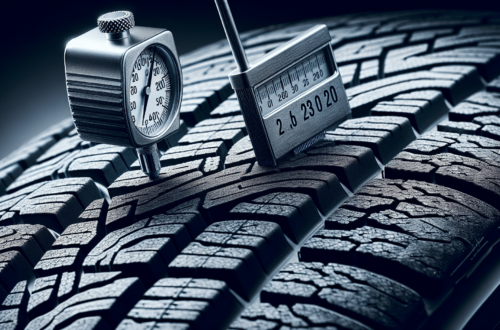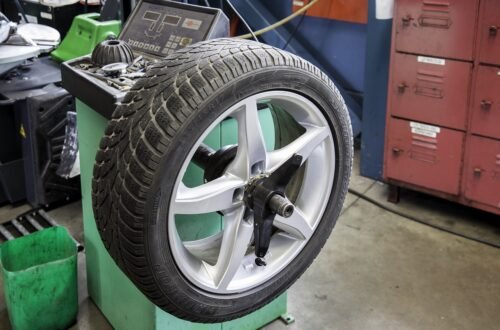Summertime is here, and as you hit the road for those long-awaited adventures, it’s crucial to ensure your tires are ready to take on the heat. With the scorching pavement and high temperatures, tire safety becomes even more vital during the summer months. From checking tire pressure to inspecting tread wear, this article will provide you with the top summer tire safety tips to keep you rolling smoothly on your journeys. So buckle up and get ready to learn how to keep your tires in tip-top shape all summer long.
Inspect Your Tires Regularly
Regular tire inspections are essential to ensure your safety on the road and the optimal performance of your vehicle. By inspecting your tires regularly, you can identify any potential issues before they become major problems. Here are a few key aspects to focus on during your tire inspections.
Check tire pressure
Maintaining proper tire pressure is crucial for several reasons. Underinflated tires can decrease fuel efficiency, affect the vehicle’s handling and braking, and even cause tire damage. Overinflated tires, on the other hand, can lead to poor traction and an increased risk of tire blowouts. Make sure to consult your vehicle’s manual or the tire manufacturer for the recommended tire pressure and use a reliable tire pressure gauge to check the pressure regularly.
Inspect tire tread depth
The tread on your tires is responsible for providing traction and grip on the road surface. As the tread wears down over time, the tire’s ability to channel water away and maintain traction decreases. To check your tire tread depth, use the penny test. Simply insert a penny into the tread groove with Lincoln’s head facing down. If you can see Lincoln’s entire head, it’s time to consider replacing your tires.
Look for signs of damage
Inspect your tires for any signs of damage, such as cuts, bulges, or punctures. These issues can weaken the structural integrity of the tire and make them more prone to failure. If you notice any significant damage, it’s crucial to have the tire inspected by a professional or replaced if necessary.
Check for uneven wear
Uneven tire wear is often an indication of misalignment or suspension problems. It can lead to poor handling, reduced fuel efficiency, and potentially dangerous situations on the road. Regularly inspect your tires for any signs of uneven wear, such as excessive wear on one side or the center of the tread. If you notice any irregular wear patterns, it’s recommended to have your tires inspected and aligned by a professional.
Maintain Proper Tire Pressure
Proper tire pressure not only ensures your safety but also affects the overall performance and lifespan of your tires. It’s important to understand the recommended tire pressure for your specific vehicle and check it regularly.
Understand recommended tire pressure
The recommended tire pressure can usually be found in your vehicle’s owner manual or on a sticker located on the driver’s side door jamb or the inside of the fuel filler door. The pressure is typically given in pounds per square inch (psi) and may vary depending on factors such as the weight distribution of your vehicle and the type of tires you have. It’s crucial to follow these recommendations to ensure optimal performance and safety.
Check tire pressure regularly
Tire pressure can fluctuate due to various factors, including changes in temperature, driving conditions, and tire wear. As a result, it’s important to check your tire pressure regularly, ideally once a month. Using a reliable tire pressure gauge, simply remove the valve cap, attach the gauge to the valve stem, and read the pressure. Compare the measured pressure to the recommended pressure, and if it’s too low, refill the tire with the required amount of air.
Refill air if necessary
If your tire pressure is below the recommended level, it’s crucial to refill it promptly. Many gas stations and automotive stores provide air filling stations, making it convenient for you to refill your tires. Remember to fill the tires evenly and avoid overinflating them, as it can lead to reduced traction and tire damage.

This image is property of images.pexels.com.
Ensure Sufficient Tread Depth
The tread depth of your tires plays a critical role in maintaining traction and ensuring safe driving, especially during the summer months when roads can be hot and dry. To ensure optimal performance, it’s important to measure the tread depth regularly and replace tires if necessary.
Measure tire tread depth
To measure your tire tread depth, you can use a tread depth gauge or the penny test mentioned earlier. The minimum legal tread depth is usually 2/32 of an inch, but for better performance and safety, it’s recommended to have at least 4/32 of an inch of tread remaining. If your tire tread depth is below the recommended threshold, it’s time to consider replacing your tires.
Replace tires if tread depth is insufficient
Driving with insufficient tread depth can significantly compromise your safety. As the tread wears down, the tire’s ability to evacuate water from under the tire diminishes, increasing the risk of hydroplaning. Additionally, tires with low tread depth have reduced grip and can compromise your vehicle’s handling and braking capabilities. If your tires’ tread depth is insufficient, it’s best to replace them promptly to ensure your safety on the road.
Consider using a tread depth gauge
While the penny test can give you a rough indication of your tire tread depth, using a tread depth gauge provides a more accurate measurement. These handy tools are affordable and easy to use. By measuring the tread depth in multiple locations on each tire, you can identify any uneven wear patterns or potential issues that may require further inspection.
Rotate Your Tires
Regularly rotating your tires is an essential maintenance practice that helps maximize their lifespan and ensure even wear. By following recommended rotation patterns and intervals, you can promote balanced tire wear and optimize their performance.
Understand tire rotation patterns
Tires can wear unevenly depending on their position on the vehicle, as different positions carry different loads and experience varying levels of stress. The most common rotation patterns include front-to-back and cross rotation. Front-to-back rotation involves swapping the front tires with the rear tires, while cross rotation involves crossing over the tires from one side of the vehicle to the other. Understanding the recommended rotation pattern for your specific vehicle is crucial for maintaining even tire wear.
Follow recommended rotation intervals
The optimal rotation interval varies depending on factors such as your vehicle’s make and model, tire type, and driving conditions. However, a general guideline is to rotate your tires every 5,000 to 8,000 miles, or every six months. By following these recommended intervals, you can ensure that all of your tires wear evenly and last as long as possible.
Consult a professional if unsure
If you’re unsure about the recommended rotation pattern or interval for your specific vehicle, it’s always best to consult a professional. Tire specialists or your vehicle’s manufacturer can provide you with the specific guidelines based on your vehicle’s specifications. They can also inspect your tires for any signs of irregular wear or other potential issues that may require attention.

This image is property of images.pexels.com.
Balance and Align Your Tires
Properly balanced and aligned tires are essential for the overall performance, stability, and longevity of your vehicle. By understanding the wheel balancing process, regularly checking the tire alignment, and seeking professional help if needed, you can ensure a smooth and safe driving experience.
Understand tire balancing process
Tire balancing involves adjusting the weight distribution of the tire and wheel assembly to eliminate any vibrations or steering wheel wobbles caused by imbalances. Over time, the balance of your tires can be affected by factors such as tire wear, hitting potholes, or simply the passage of time. If you notice any vibrations or a shaky steering wheel, it might be time to have your tires balanced by a professional.
Check tire alignment
Proper tire alignment ensures that your tires are parallel to each other and perpendicular to the road. Incorrect alignment can lead to uneven tire wear, poor handling, and compromised fuel efficiency. Signs of misalignment include the vehicle pulling to one side, uneven tire wear, or a crooked steering wheel when driving straight. If you notice any of these signs, it’s important to have your tires professionally aligned.
Get professional help if needed
While basic tire balancing and alignment can be done at home with the proper tools and guidance, it’s recommended to seek professional help for accurate and precise results. Automotive service centers or tire specialists have the necessary equipment and expertise to ensure your tires are balanced and aligned correctly. Regularly scheduling appointments for tire balancing and alignment can help extend the lifespan of your tires and provide a comfortable driving experience.
Avoid Overloading Your Vehicle
Overloading your vehicle can put excessive stress on your tires, leading to accelerated wear, decreased handling, and increased risk of tire failure. By knowing your vehicle’s weight limit, avoiding exceeding the recommended load capacity, and distributing weight evenly, you can help maintain tire integrity and improve overall safety.
Know your vehicle’s weight limit
Every vehicle has a recommended weight limit, also known as the gross vehicle weight rating (GVWR). This refers to the total weight your vehicle can safely carry, including passengers, cargo, fuel, and accessories. You can find this information in your vehicle’s manual or by checking the driver’s side door jamb. It’s important not to exceed this limit to prevent unnecessary strain on your tires and other components.
Avoid exceeding recommended load capacity
Exceeding the recommended load capacity places excessive stress on your tires and the vehicle’s suspension system. It can lead to accelerated tire wear, decreased handling and braking performance, and potential mechanical issues. When loading your vehicle, be mindful of the weight of the items you’re carrying and ensure that the total weight does not exceed the recommended limit.
Distribute weight evenly
Proper weight distribution is critical to maintaining tire integrity and ensuring balanced handling. When loading your vehicle, distribute the weight as evenly as possible to prevent placing unnecessary strain on specific tires. Avoid overloading one side of the vehicle or the rear, as it can lead to uneven tire wear and affect the vehicle’s stability. Properly securing your cargo and evenly distributing weight can help maximize tire performance and overall safety.

This image is property of images.pexels.com.
Drive Smoothly and Responsibly
Your driving habits have a significant impact on the life of your tires. By driving smoothly, avoiding sudden acceleration or braking, not cornering aggressively, and maintaining moderate speeds, you can maximize your tires’ lifespan and ensure a safe driving experience.
Avoid sudden acceleration or braking
Sudden acceleration or aggressive braking can put excessive stress on your tires, causing them to wear unevenly and prematurely. By gradually accelerating and smoothly decelerating, you can minimize the strain on your tires and improve fuel efficiency. Smooth driving practices can also enhance passenger comfort and reduce the risk of accidents.
Don’t corner aggressively
Aggressive cornering puts additional stress on the tires, causing them to wear faster on the edges. When taking turns, maintain a moderate speed and smoothly steer into the corner. Avoid abrupt or jerky steering movements, as they can result in loss of traction and compromise your safety.
Drive at moderate speeds
Driving at excessive speeds generates additional heat within the tires, which can lead to accelerated tire wear and reduced performance. It’s important to respect speed limits and drive at a moderate pace. This not only helps maintain the integrity of your tires but also contributes to a safer driving environment for yourself and others on the road.
Be Mindful of Extreme Temperatures
Hot summer weather and drastic temperature changes can affect tire performance and safety. By understanding how tires react to hot and cold weather, monitoring tire pressure during temperature changes, and adjusting your driving style accordingly, you can ensure optimal tire performance throughout the summer.
Understand tire performance in hot and cold weather
Extreme temperatures can impact tire pressure and tire compounds, affecting their grip and overall performance. In hot weather, the air inside the tire expands, potentially leading to overinflation. Hot pavement can also cause the rubber compounds to soften, resulting in reduced traction. Conversely, cold weather causes the air inside the tire to contract, leading to underinflation. The rubber compounds can also harden, resulting in decreased flexibility and grip. Understanding these effects helps you adapt your driving habits and maintain proper tire pressure.
Monitor tire pressure during temperature changes
Fluctuations in temperature can cause tire pressure to vary. It’s important to monitor tire pressure regularly, especially during temperature changes. If you notice a significant change in tire pressure, adjust it to the recommended level. This will help ensure optimal tire performance and prevent potential issues caused by over or underinflation.
Adjust driving style accordingly
Driving style should be adjusted to suit the prevailing weather conditions. In hot weather, be mindful of reduced tire grip and avoid aggressive maneuvers that can lead to tire slip or loss of control. During colder weather, allow your tires a few minutes to warm up before driving and maintain a safe following distance to account for potentially reduced traction. Being aware of the temperature-dependent characteristics of your tires can help you drive safely and avoid potential accidents.
Keep a Spare Tire and Necessary Tools
Having a spare tire and the necessary tools for changing a tire is essential in case of a flat or blowout. By carrying a spare tire, having the right tools for the job, and knowing how to use them, you can minimize the inconvenience and ensure a prompt resolution to tire-related issues.
Carry a spare tire
Ensure that your vehicle is equipped with a reliable spare tire. Whether it’s a full-size spare or a compact temporary spare, having a spare tire allows you to quickly replace a damaged tire and continue your journey. Regularly inspect your spare tire to ensure that it is properly inflated and in good condition. If your vehicle is not equipped with a spare tire, consider purchasing one as a precautionary measure.
Have essential tools for changing a tire
To change a tire, you will need a few essential tools, including a lug wrench, a jack, and a wheel chock. The lug wrench is used to loosen and tighten the lug nuts, while the jack lifts the vehicle off the ground. A wheel chock helps secure the vehicle in place while you work on changing the tire. Familiarize yourself with these tools and ensure they are in working condition and easily accessible in your vehicle.
Know how to use them
It’s essential to know how to properly use the tools for changing a tire. Consult your vehicle’s owner manual for specific instructions on how to safely jack up your vehicle and remove and replace the tire. Familiarize yourself with the process before encountering a tire emergency, as it will help you feel more confident and capable when the need arises.
Consider Summer-Specific Tires
In hot summer weather, the right type of tires can provide enhanced performance, improved handling, and increased safety. Consider investing in specialized summer tires to optimize your driving experience during the warmer months.
Explore specialized summer tires
Summer tires, also known as performance tires, are designed specifically for warm weather conditions. They offer superior grip, increased responsiveness, and improved handling on both dry and wet roads. Summer tires typically feature a tread pattern optimized for warm temperatures and are constructed with a rubber compound that remains pliable in hot weather. If you frequently drive in areas with hot summers, a switch to summer tires can significantly enhance your driving experience.
Understand their benefits and features
Summer tires offer several benefits over all-season or winter tires. They provide increased traction and shorter stopping distances, contributing to improved safety. Their enhanced cornering ability and responsiveness make for a more enjoyable and engaging driving experience. Additionally, summer tires often have reduced rolling resistance, which can improve fuel efficiency. Understanding the specific features and benefits of summer tires can help you make an informed decision when considering a tire replacement.
Consult with tire experts
Choosing the right tires for your vehicle and driving needs can be overwhelming. If you’re considering summer tires, it’s beneficial to consult with tire experts or visit a tire specialist. They can assess your specific requirements, recommend suitable tire options, and provide valuable insights into the performance characteristics of different brands and models. Trusting the expertise of professionals can help you make an informed decision and ensure you select the best tires for your summer driving needs.
By following these important summer tire safety tips and incorporating them into your regular maintenance routine, you can enjoy a safe and worry-free driving experience throughout the summer months. Regular inspections, proper tire pressure maintenance, and responsible driving habits will not only extend the life of your tires but also ensure your safety and the safety of those on the road. Remember, a little care and attention go a long way when it comes to your tires.





